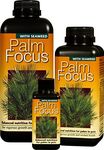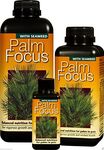Buying Guide for the Best Palm Tree Fertilizers
Choosing the right fertilizer for your palm tree is crucial for its health and growth. Palm trees have specific nutritional needs that differ from other plants, and using the correct fertilizer can help ensure they receive the necessary nutrients. When selecting a fertilizer, consider the type of palm tree you have, its age, the soil conditions, and the climate in your area. Understanding the key specifications of palm tree fertilizers will help you make an informed decision that supports the vitality and longevity of your palm tree.NPK RatioThe NPK ratio represents the percentage of nitrogen (N), phosphorus (P), and potassium (K) in the fertilizer. This ratio is important because it indicates the balance of nutrients that the fertilizer will provide to your palm tree. Nitrogen promotes leaf growth, phosphorus supports root development, and potassium enhances overall health and disease resistance. For palm trees, a balanced NPK ratio such as 3-1-3 or 8-2-12 is often recommended. When choosing the right NPK ratio, consider the specific needs of your palm tree and the nutrient deficiencies in your soil.
MicronutrientsMicronutrients are essential elements required in small amounts for the healthy growth of palm trees. These include magnesium, manganese, iron, and zinc, among others. Micronutrients are important because they help prevent deficiencies that can lead to yellowing leaves and poor growth. Fertilizers with added micronutrients are beneficial for palm trees, especially if your soil lacks these elements. To choose the right fertilizer, assess the micronutrient content and ensure it matches the specific needs of your palm tree and soil conditions.
Slow-Release vs. Quick-ReleaseFertilizers can be either slow-release or quick-release, which refers to how quickly the nutrients are made available to the plant. Slow-release fertilizers gradually provide nutrients over an extended period, reducing the risk of nutrient burn and requiring less frequent application. Quick-release fertilizers deliver nutrients rapidly, which can be beneficial for immediate nutrient deficiencies but may require more frequent applications. When selecting a fertilizer, consider the growth stage of your palm tree and your maintenance preferences. Slow-release is often preferred for consistent, long-term feeding.
Application MethodThe application method refers to how the fertilizer is applied to the palm tree. Common methods include granular, liquid, and spike fertilizers. Granular fertilizers are spread on the soil surface and watered in, providing a slow release of nutrients. Liquid fertilizers are mixed with water and applied directly to the soil or foliage, offering quick nutrient absorption. Spike fertilizers are inserted into the soil and release nutrients over time. Choose the application method that best suits your palm tree's needs, your soil type, and your personal convenience.
Organic vs. SyntheticFertilizers can be organic or synthetic. Organic fertilizers are made from natural materials and release nutrients slowly as they break down, improving soil health and structure. Synthetic fertilizers are chemically manufactured and provide nutrients more quickly. The choice between organic and synthetic depends on your gardening philosophy and the specific needs of your palm tree. Organic fertilizers are ideal for those who prefer natural gardening practices, while synthetic fertilizers may be suitable for addressing specific nutrient deficiencies more rapidly.


















